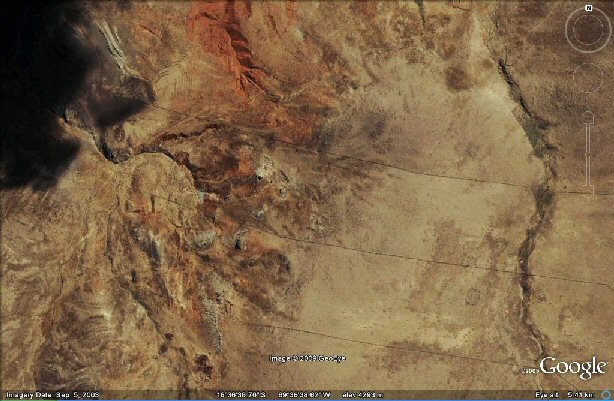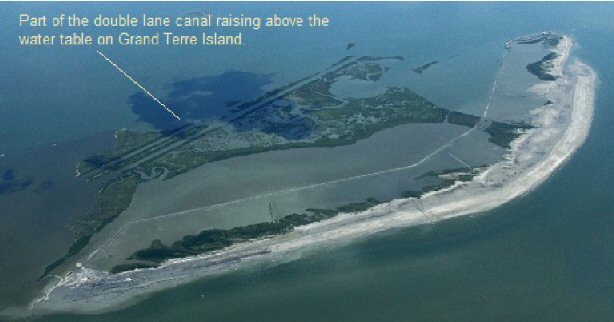|
 Ancient
Canal Systems in the Americas: Ancient
Canal Systems in the Americas:
 The
realisation of extensive ancient canal systems,
harbours, quays and other (now underwater) earthworks in
Florida and Louisiana has certainly raisede a few eyebrows and has inspired
debate as to their origin.
Some of the canals are 5ft underwater, leading to claims
of their being onwards of 7,000 years old
(1),
which is a considerable way from the first serious attempts to build
American canals in recent times at around 1780, following
independence from Great Britain.
(6),
but is supported by discoveries of burials of humans in Florida at the
same time, as evidenced by the remains of the 167 Windover
'Bog-people' bodies dated c. 7,000 BP
(3).
The examples below show that canal building was something that
was understood in the Americas long before the arrival of
Europeans. Of most interest however, are those canals that are
reported as being underwater, as they suggest the existence of
ancient and unknown culture. The
realisation of extensive ancient canal systems,
harbours, quays and other (now underwater) earthworks in
Florida and Louisiana has certainly raisede a few eyebrows and has inspired
debate as to their origin.
Some of the canals are 5ft underwater, leading to claims
of their being onwards of 7,000 years old
(1),
which is a considerable way from the first serious attempts to build
American canals in recent times at around 1780, following
independence from Great Britain.
(6),
but is supported by discoveries of burials of humans in Florida at the
same time, as evidenced by the remains of the 167 Windover
'Bog-people' bodies dated c. 7,000 BP
(3).
The examples below show that canal building was something that
was understood in the Americas long before the arrival of
Europeans. Of most interest however, are those canals that are
reported as being underwater, as they suggest the existence of
ancient and unknown culture.
|
Analysis
of the Underwater Canals: |
'There
are many underwater harbours, channels and canals in Florida and
Louisiana, as well as other areas, that are covered
with vestiges and remnants of a very sophisticated, enormously
large aquatic based culture or civilization that existed BEFORE
current sea level rose an average of 5 feet'.
(1)

Sea level rise based on data from Fleming et al.
1998, Fleming 2000, & Milne et al. 2005. The 5ft level in the
region of Jamaica has been ringed at just under 7,000 BP,
supporting the suggestions by Jensen that the submerged sites
are potentially thousands of years old.
Image Credits:
http://www.globalwarmingart.com
We know from
the public record that canal systems weren't in use in the
Americas until at least 1780, so anything from before then is a
relic of a previous culture. The question then is, what were
they used for and by whom.? The pictures of harbours and sea
ports, Quays etc suggest that the canal systems were used to
transport things to the then existing coastline. The size and
complexity of some of the canal systems suggests that they were
in use for some time, and with much time and effort invested on
them.
The Ortona Park canal system, Florida. An
Example.
Following a GPR
Ground Penetrating Radar survey of the area, evidence of an
ancient canal system that has been documented since the 1800's
was confirmed. It is known that native Americans populated the
area as far back a 300-400 AD, and that they built a large
man-made canal system to circumvent traffic from a nearby river
and take them from the surrounding area to their 'town' centre.
The canal system is several miles long and is 'too large to
excavate in its entirety'. Although the area is being considered
for development and the canals are all but silted over, the site
has been recognised for its historical importance and sections
of the canal system will be likely retained for posterity.
(7)
The Peruvian Andes:

Image Credits:
canalsperuview.htm
New discoveries in
the Peruvian Andes have pushed back the earliest discovery of canals
(for irrigation) in the Pre-Columbian Americas by thousands of
years. In the Andes researchers have found three canals that
date to at least 5,400 years ago buried by sediment layering. A
fourth possible canal was also found, which special radiocarbon
dating techniques revealed to be 6,700 years old.
(2)
The canals were shallow and quite narrow. They were lined with
pebbles and larger stones and measured anywhere from less than one
mile to more than two miles long.
Grand Terre Island, LA.

This is a section
of double lane canal which rises above the water table as it
traverses the Delta from East of Golden Meadows to the circle
complex at the salt mounds west of Venice. The underwater section is
over twelve miles to the west and more than sixteen miles underwater
to the east.
The Hohokum Rover canal system. Phoenix, Arizona.

The map above is
based on work done by Omar Turney in 1929. According to him, the
system encompassed "the largest single body of land irrigated in
prehistoric times in North or South America, and perhaps in the
world". The system utilized at least 1000 miles (1600 km) of
canals and irrigated over 100,000 acres (40,470 hectares) of land.
The area shown measures about 50 miles (80 km) West to East, by 40
miles (64km) North to South, and encompasses approximately 2000
square miles (5200 km). It was built c. 500 - 1,500 AD By the 'Hohokum'
people. (4)
Arizona has a tradition of ancient canal building that dates back
almost 3,000 years, although the earliest ones found are on a
smaller scale, archaeologists have uncovered a complex canal system
that dates between 1,200 and 800 B.C. Known as Las Capas ("the
layers" in Spanish), it was the earliest large-scale system of its
kind in the Southwest, and was built by people belonging to what
archaeologists call the San Pedro Phase Culture. "It is the best
exposure of an early canal system of just about any pre-Columbian
time period in North America to date," said project director James
Vint. (5)
Satellite images of
ancient canal systems in Peru.:
http://www.atlantisbolivia.org/canalsperuview.htm
Satellite images of
ancient canal systems in Bolivia:
http://www.atlantisbolivia.org/canalsgallery.htm
|
 The
realisation of extensive ancient canal systems,
harbours, quays and other (now underwater) earthworks in
Florida and Louisiana has certainly raisede a few eyebrows and has inspired
debate as to their origin.
Some of the canals are 5ft underwater, leading to claims
of their being onwards of 7,000 years old
(1),
which is a considerable way from the first serious attempts to build
American canals in recent times at around 1780, following
independence from Great Britain.
(6),
but is supported by discoveries of burials of humans in Florida at the
same time, as evidenced by the remains of the 167 Windover
'Bog-people' bodies dated c. 7,000 BP
(3).
The examples below show that canal building was something that
was understood in the Americas long before the arrival of
Europeans. Of most interest however, are those canals that are
reported as being underwater, as they suggest the existence of
ancient and unknown culture.
The
realisation of extensive ancient canal systems,
harbours, quays and other (now underwater) earthworks in
Florida and Louisiana has certainly raisede a few eyebrows and has inspired
debate as to their origin.
Some of the canals are 5ft underwater, leading to claims
of their being onwards of 7,000 years old
(1),
which is a considerable way from the first serious attempts to build
American canals in recent times at around 1780, following
independence from Great Britain.
(6),
but is supported by discoveries of burials of humans in Florida at the
same time, as evidenced by the remains of the 167 Windover
'Bog-people' bodies dated c. 7,000 BP
(3).
The examples below show that canal building was something that
was understood in the Americas long before the arrival of
Europeans. Of most interest however, are those canals that are
reported as being underwater, as they suggest the existence of
ancient and unknown culture.


